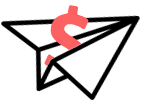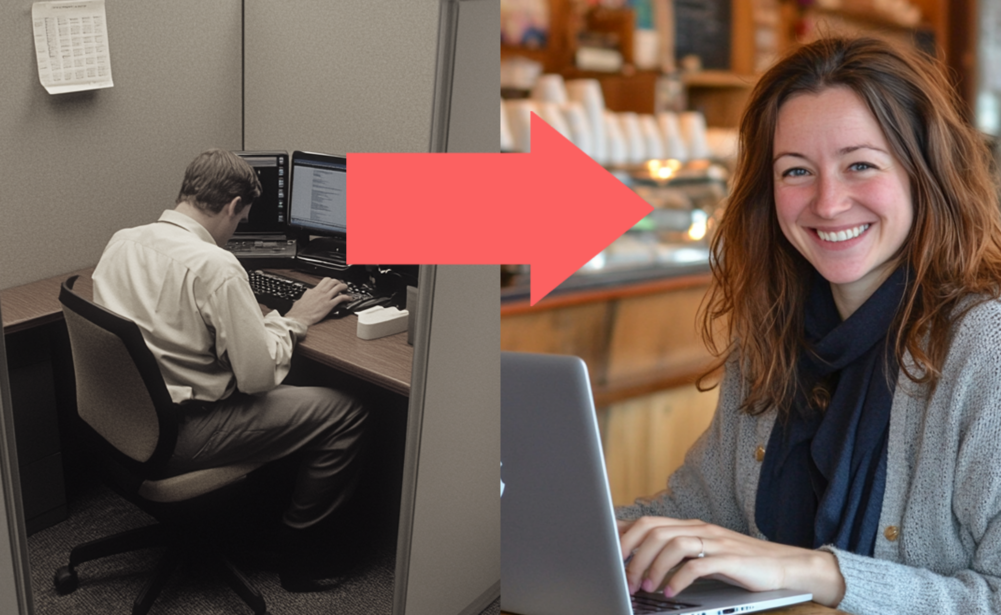Let’s imagine you want to start a freelance business instead of working a 9–5 job in marketing, advertising, or communications. You might work as a filmmaker, writer, graphic designer, or front-end programmer. Freelancing had an undeniable allure for me. The unmatched flexibility and potential for greater income were two reasons I transitioned from full-time employment to freelancing.
How did I make that move? Like many, I didn’t have the financial means to quit my job and start freelancing immediately. Even though I was freelancing a little on the side, it wasn’t enough to support me full-time. Here is how I managed.
Top Tips to Transition From Full-Time Employment to Freelancing
The World Bank estimates that around 47% of workers globally are independent contractors. In fact, by 2027, the worldwide market for freelance platforms has the potential to grow to $9.19 billion.

Get Weekly Freelance Gigs via Email
Enter your freelancing address and we'll send you a FREE curated list of freelance jobs in your top category every week.
The appeal of working from anywhere, setting my rates, following my passion, and having more control over my life was strong. However, there are also challenges—like inconsistent income, limited benefits, loneliness, competition, and uncertainty. One way to mitigate these challenges is by exploring sites for freelancers that offer valuable resources and client connections. Here are the top tips for transitioning from full-time employment to freelancing that I found helpful.
Evaluating Your Preparation
I asked myself a few key questions before I decided to leave my full-time job and dive into freelancing.
- Do I have savings that will last at least six months to pay for living expenses?
- Do I possess a strong portfolio that highlights my abilities and background?
- Do I stand out from other freelancers with a varied skill set?
- Am I aware of the demand for my skills and the freelance market?
You can assess your competitive edge, market opportunity, financial stability, and professional reputation with the use of these questions. You’re prepared to move on to the next phase if you say “yes” to each of them. If not, you must make these improvements before moving forward.
Here are some pointers on how I determine my level of preparation.
Assess Your Level Of Financial Stability
I made sure to save enough to cover at least six months of living expenses. This safety net gave me peace of mind while building my freelance client base.
Building a Strong Portfolio
My portfolio became my best tool for showcasing my skills and experience. I kept it up-to-date and relevant, including my best work, client testimonials, and any awards or recognition I had earned.
Expanding Your Skill Set
The more skills I had, the more value I could offer clients. I regularly learned through webinars, podcasts, books, and online courses to keep my skills sharp.
Understanding the Freelance Market
I made sure there was a demand for my services by researching my target market and figuring out how to stand out from competitors.
Establishing a Strategic Plan
After I evaluate my preparedness, I need to draft a strategic plan that includes my goals and objectives, target market and niche definition, income and budget estimations, and a list of probable problems and remedies.

These are some pointers for writing a strategic plan:
- Establish definite goals and objectives.
- Identify my niche and target market.
- Calculate my income and expenses.
- Recognising possible issues and their fixes
Make backup plans and remedies for every problem encountered. These could include engaging a lawyer, utilizing a project management tool, establishing a payment schedule, or finding an extra client.
Developing Your Internet Identity
While I was still employed full-time, I began building my freelance presence. My online presence—my portfolio, testimonials, social media profiles, and website—helped me showcase who I was and what I could do.
Here are some pointers for increasing web visibility.
Create a Strong Freelance Brand
The way you show yourself to clients is your freelance brand. Your name, logo, tagline, mission, values, tone, and so forth are all included. It needs to be dependable, genuine, and unforgettable. Even something as basic as your LinkedIn profile can help you build your brand.
Build or Maintain a Business Website
Your website features your portfolio, services, references, contact details, and more. This implies that you use your website to showcase your accomplishments, remarks from others, contact information, and other information. You can get assistance from a website.
Make Your Social Media Profiles More Effective
You may interact with influencers, colleagues, and clients through your social media sites. Choose the platforms based on your audience and industry.
Showcase Your References and Portfolio
Potential employers or clients can see what you can do and how you have assisted others in the past from your portfolio and testimonials. They are essential for establishing credibility and trust as well as for showcasing your worth and accomplishments.
Marketing and Networking
This is a continuation of building your presence, but in this case, you’re actively seeking out collaborators. The two most important things I do to identify and draw clients for my freelance business are networking and marketing. They entail making contact with individuals who have the potential to expand your network, reputation, and revenue.
The following advice can help you market and network:
- Making the most of your professional network
- Looking into freelance websites
- Going to meetings and events for the industry
Productivity and Time Management
I have scheduling and hour control as a freelancer. But I also have to manage other projects, clients, deadlines, and interruptions. To fulfill my goals and produce high-quality work, I must efficiently and effectively manage my time.
Here are some tips for time and productivity management that I always find helpful:

- I make a work plan that works for my tastes, way of life, and workload.
- Utilize various time management strategies to prioritize assignments, keep myself organized, stop procrastinating, etc.
- Strike a good balance between my personal and professional lives. Make time for hobbies, leisure activities, social connections, and other pursuits; I never overwork myself or ignore my needs.
Getting Comfortable With Being a Freelancer
The independence that comes with freelancing may feel incredibly freeing to someone no longer required to work a 9–5. Without outside deadlines, though, time management can also be difficult. I get to choose my clients, tasks, and schedule when I work for myself. However, I also need to have resilience, discipline, and flexibility.
I had a full-time job as a copywriter. I worked a little as a freelancer on the weekends and evenings. Then the ideal opportunity—one that might also work for you—was presented to me. A friend of mine who worked as an executive at a medium-sized agency called. He came up with a compelling proposition. Ideally, you should be able to support yourself while developing your business with the freelancing work you do. Having savings or a financially stable relationship is beneficial. Just be prepared to have less money for up to a year or longer.
Furthermore, setting up a home office that maximizes productivity and reduces distractions is one of the most important steps in making the switch to freelancing. This ensures that I have a dedicated area where I can concentrate on my job.
Managing Difficulties and Burnout
I can choose my projects and clientele, but there’s still uncertainty and tension involved. How did I handle the highs and lows of working as a freelancer?
The following advice helped me deal with obstacles and burnout:
Be Ready
To deal with changes in workload and revenue, continually plan, save, and market your services. This will help you be ready if you become unemployed due to a client abruptly terminating your relationship.
Handle Challenges in a Professional Manner
When working with challenging clients or projects, know when to give up, establish clear limits, and resolve conflicts professionally.
Watch for Signs of Burnout
Keep an eye out for signs of burnout, take regular breaks, and take care of yourself. Because there are often no clear boundaries between work and personal life, pressure to meet deadlines and customer expectations, and the loneliness of working alone, freelancers may be especially vulnerable to burnout.
A few useful suggestions are prioritizing self-care activities like exercise, meditation, or hobbies, setting realistic and doable goals, taking regular breaks during the day, and asking friends, family, or other freelancers for social support.
Recognizing Achievements and Milestones
Making the switch from a full-time job and becoming a freelancer can be difficult, and you need to look after yourself during this time. You deserve to treat yourself to something for all of your hard work and accomplishments, no matter how tiny.
Here are some pointers I always do for recognizing my accomplishments and milestones:
- Celebrate my achievements as a freelancer with a smile and treat myself to experiences or goods I’ve wanted for a while.
- Set challenging yet reachable goals to propel myself to the next level of freelancing.
- Through social media or online communities, share my experience as a freelancer with the world and kindle a spark in others.
- Love working for myself and feel appreciative of the opportunities and benefits.
Final Words
Making the switch from full-time employment to freelancing can be a fruitful and satisfying professional decision. I had a solid plan, a network of allies, and the capacity to handle pressure and unpredictability well enough to succeed. With the correct planning and concentration, freelancing turned into a flexible and satisfying job option for me.

Keep the conversation going...
Over 10,000 of us are having daily conversations over in our free Facebook group and we'd love to see you there. Join us!



